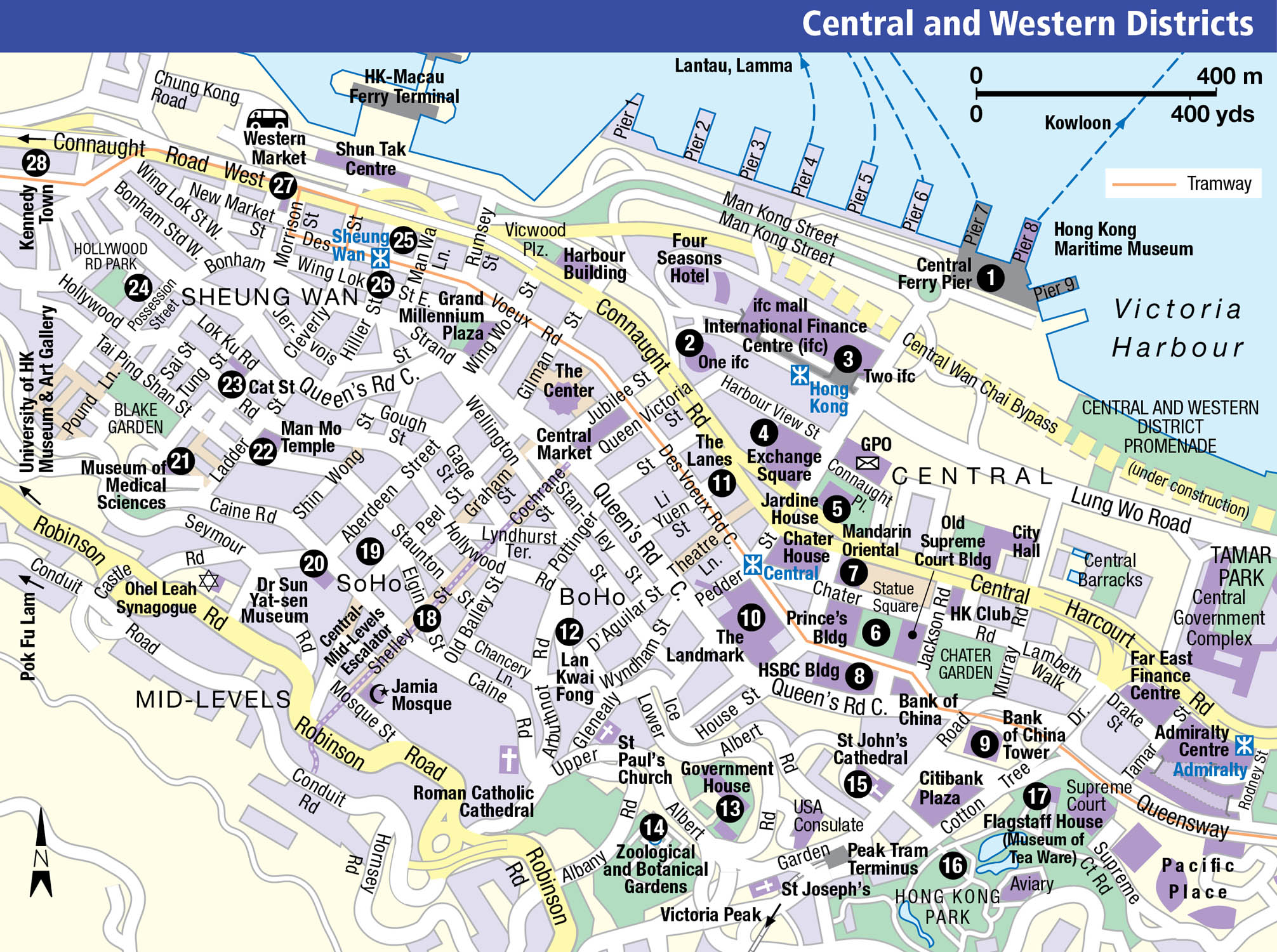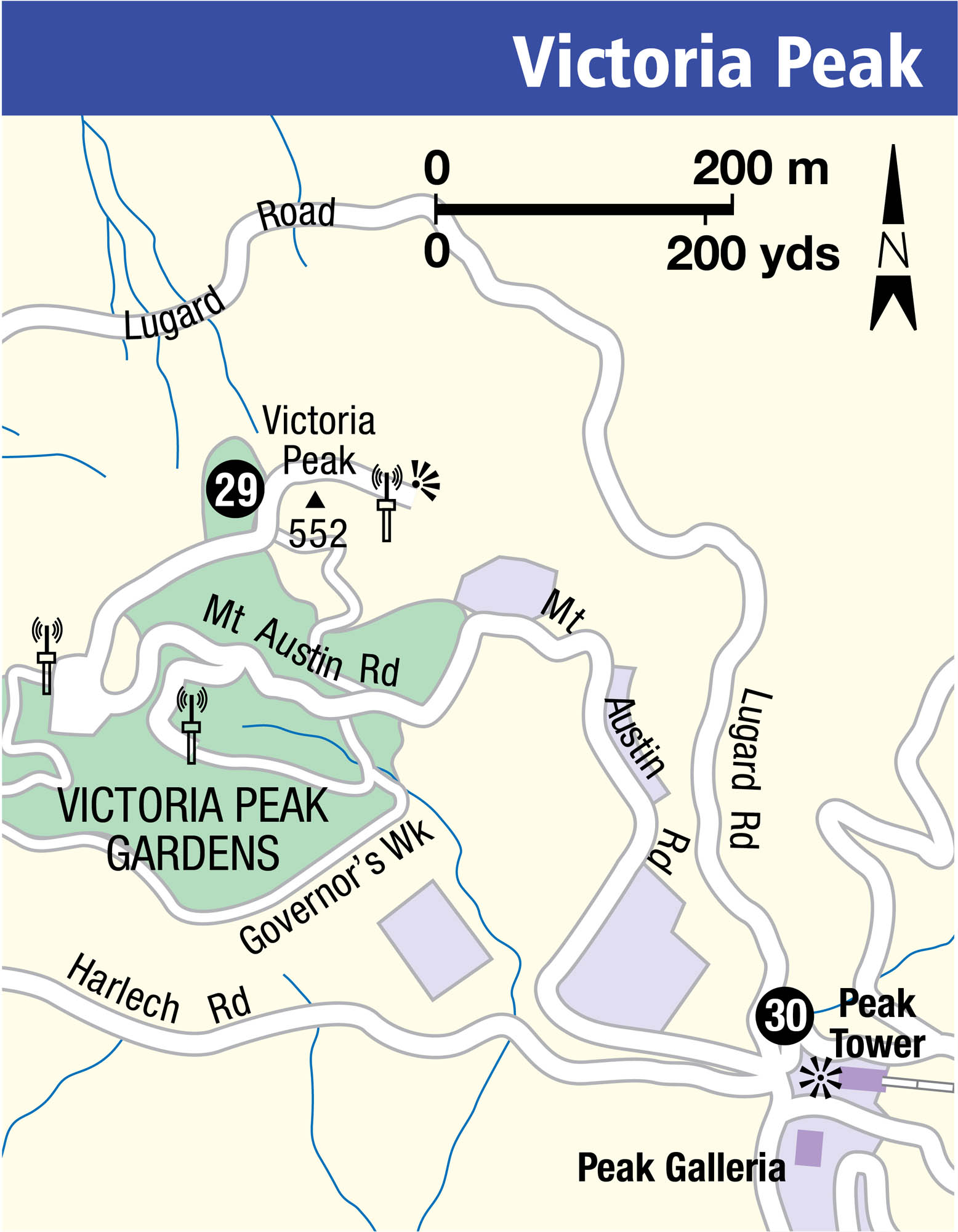Maps and Listings
Central District – Chung Wan in Cantonese – is Hong Kong’s business and financial hub, at the heart of the incredible cliff-face of high-rise buildings that extends along the north shore of Hong Kong Island. Wedged between the harbour and the precipitous slopes of Victoria Peak, this is where the money is: the financial powerhouses and glamorous high-end shopping malls, overlooked by the multi-millionaires’ mansions up on The Peak.
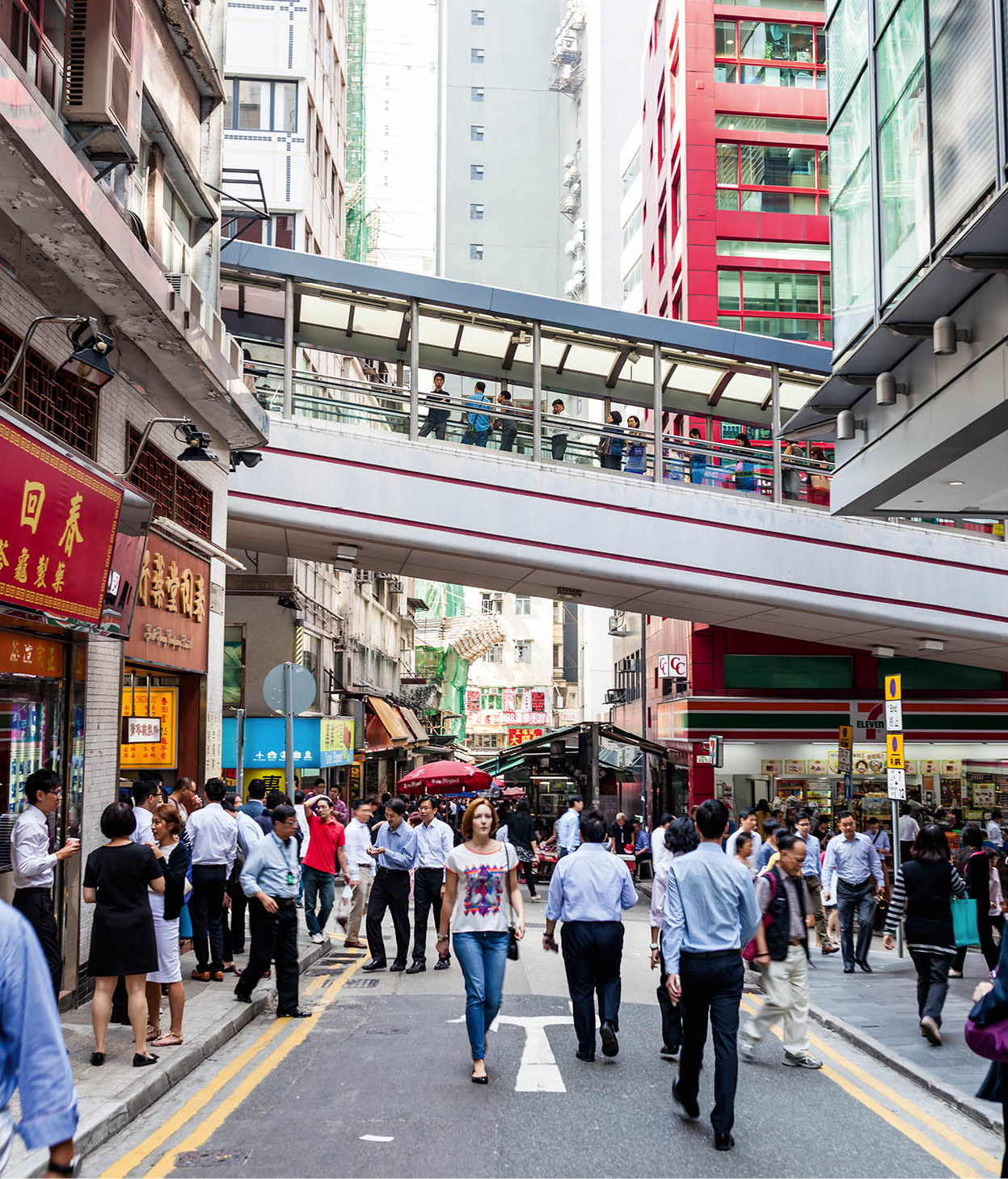
The Central-Mid-Levels escalator is an extensive system of outdoor covered escalators
Ming Tang-Evans/APA Publications
To the west, Sheung Wan and Western District retain more elements of Hong Kong’s past; this was the area that the British established as Victoria City in the 1840s, and from here the city has expanded and grown in every direction, including upwards. It all adds up to one of the most fascinating areas of modern Hong Kong.
Yet, like the rest of Hong Kong, there are few conventional tourist sights here: despite the efforts of the tourist board to highlight the past with such innovations as the Sun Yat-sen Trail, most of the “landmarks” en route are simply plaques recording some building or other that has long since disappeared. Instead, the fascination is in the contemporary, the everyday life of the place, the drama of the architecture, the amazing contrasts of scale and the sheer energy that emanates from the crowded streets.
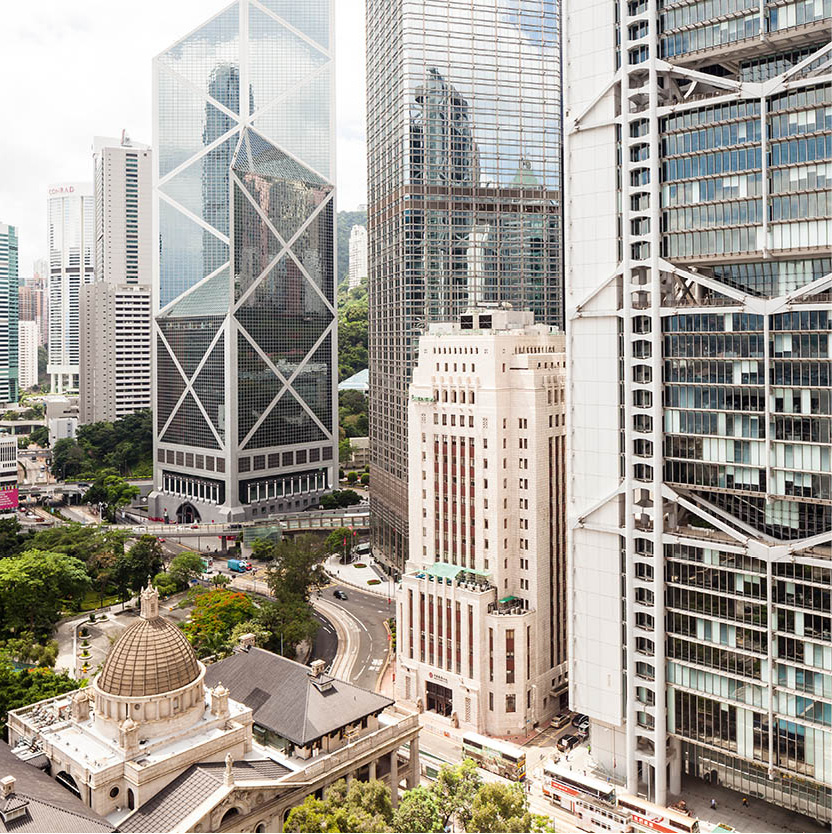
From left to right is the Bank of China, the HSBC building and the Old Supreme Court Building.
Ming Tang-Evans/APA Publications
And although most of the pedestrians on Central’s streets are attired for business, and giant video screens flash the latest news and financial figures from around the world to passers-by, there are still strong elements of former days, with wayside hawkers selling novelties and knock-offs, incense sticks smouldering by tiny shrines, and delivery boys serenely pedalling through red lights with a cargo of fresh meat balanced in their bike’s cast-iron basket.
The financial centre
The Central Ferry Pier 1 [map], the terminal for the Star Ferry on Hong Kong Island, is as good a place as any to begin exploring Central. With reclamation continually narrowing the harbour, the Star Ferry has been forced to relocate to a new site next door to the outlying islands’ ferry piers. It features Edwardian-style embellishments and is more user-friendly than its 1950s predecessor, Edinburgh Place, which sparked protests by conservationists when it was demolished in 2007. Having seen many such upheavals since its formation in the 19th century, the Star Ferry Company was more philosophical about the move. (For more on the Star Ferry, for more information, click here.)
The recently relocated and beautifully presented Hong Kong Maritime Museum (Mon–Fri 9.30am–5.30pm, Sat–Sun 10am–7pm; charge) traces Hong Kong’s long connection with the sea. The museum is laid out over three floors of Central Ferry Pier 8, with the more than a dozen galleries including a look at historic trade and sea routes with both China and the West and an immersive sense of a sailor’s life at sea. It makes for a great introduction to the role of shipping in Hong Kong historic development and contemporary prosperity.
The prosaically named International Finance Centre (IFC) 2 [map], a combination of smart shopping mall and offices, sits atop the Airport Express Central terminal. Just to the north in front of the ferry piers, and part of the same complex, is the International Finance Centre Two (Two ifc) 3 [map]. It stands at 415 metres (1,362ft), which makes it currently the 17th-tallest building in the world (fully 34 metres/112ft higher than the Empire State Building), and is capped by a mass of curving spires. When it was finished in 2003, IFC2 became the tallest of Hong Kong’s 7,500-odd high-rise buildings, but in 2010 that title passed to the International Commerce Centre (ICC) across the harbour in West Kowloon (for more information, click here). Unfortunately there is no public access to the upper floors as they are leased by the Hong Kong Monetary Authority. The authority does open up to the public on the 55th floor with the HKMA Information Centre (Mon–Fri 10am–6pm, Sat 10am–1pm; free) where there are several interesting exhibits on Hong Kong’s financial history as well as outstanding views over Central. Lower down, on the fifth floor, there is a pleasant outside terrace with bars and restaurants above the Lane Crawford department store. The tower block on the west side of the IFC houses the super-luxury Four Seasons Hotel.

Taxis surrounded by pedestrian walkways.
Ming Tang-Evans/APA Publications
Walkways connect the IFC to the rest of Central via Exchange Square 4 [map], home of the Hong Kong Stock Exchange. On the first floor of One and Two Exchange Square, the Exchange Exhibition Hall (open trading days 9.30am–5pm, last admission 3.30pm; charge) allows visitors to view the Trading Hall in action and to learn about the development of Hong Kong’s financial markets.
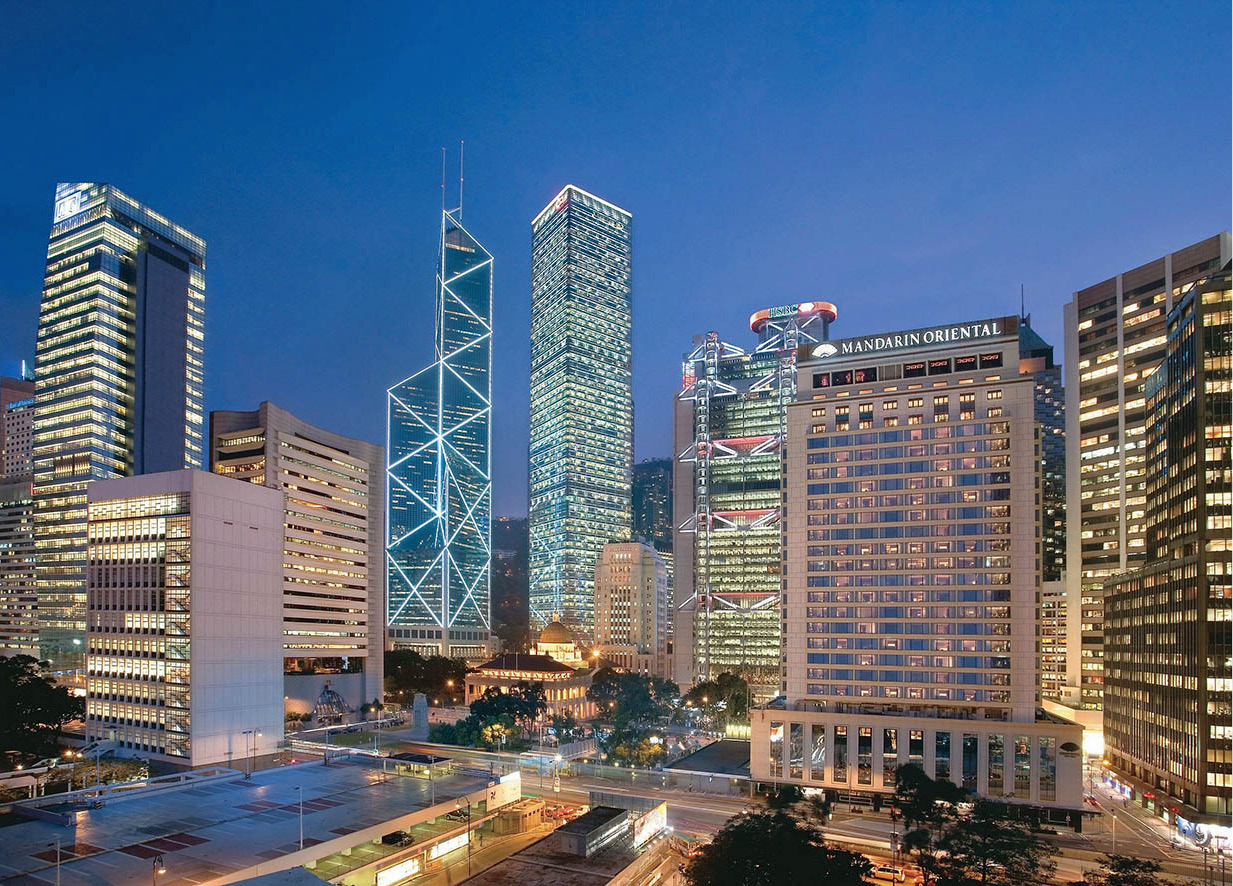
Hong Kong Island’s skyline including the Mandarin Oriental Hotel.
Mandarin Oriental Hotel Group
Head east along the walkway to Jardine House 5 [map], whose distinctive 1,700-plus round windows have inspired the nickname “House of a Thousand Orifices”. Opened in 1973 (when it was known as the Connaught Centre), it was for many years the tallest building in Hong Kong. Just behind is the General Post Office (GPO), and beyond that City Hall, which lost its waterfront position in 2008 when the (supposed) final part of the Central Wan Chai reclamation was built.
It’s possible to get a good overview of all the current reclamation and proposals at the City Gallery (daily 10am–6pm) on Edinburgh Place. This four-floor exhibition has a number of creatively designed and highly interactive exhibitions on major engineering projects of the past, present and future. The adjacent City Hall not only houses administrative offices, but a concert hall, theatre, marriage registry and three restaurants, including the popular Maxim’s Palace (for dim sum).
Tip
To get the most out of a walking tour of Central, visit on a weekday during working hours, as (Lan Kwai Fong/SoHo apart) this is not one of Hong Kong’s after-hours locations – unlike Tsim Sha Tsui and Causeway Bay, many shops close by 7pm. Shops are open on Saturdays, but the energised atmosphere of the working week is lacking. Sundays are quiet, with shops shut, although the weekly Filipina get-together is in full swing.
East to Statue Square
Between City Hall and the GPO, an underpass will take you to Statue Square 6 [map] and Chater Road. On Sundays, throngs of Filipina maids gather here on their day off in a festive outdoor party. The 133,000 Philippine nationals, most of whom work here as maids, are the joint-largest foreign community living in Hong Kong – over double the number of British, Canadian, Australian and American passport-holders, who total around 70,000 in all. The 2011 census revealed an equal number of Indonesian residents, who have a similar Sunday habit but tend to meet up in Causeway Bay’s Victoria Park.
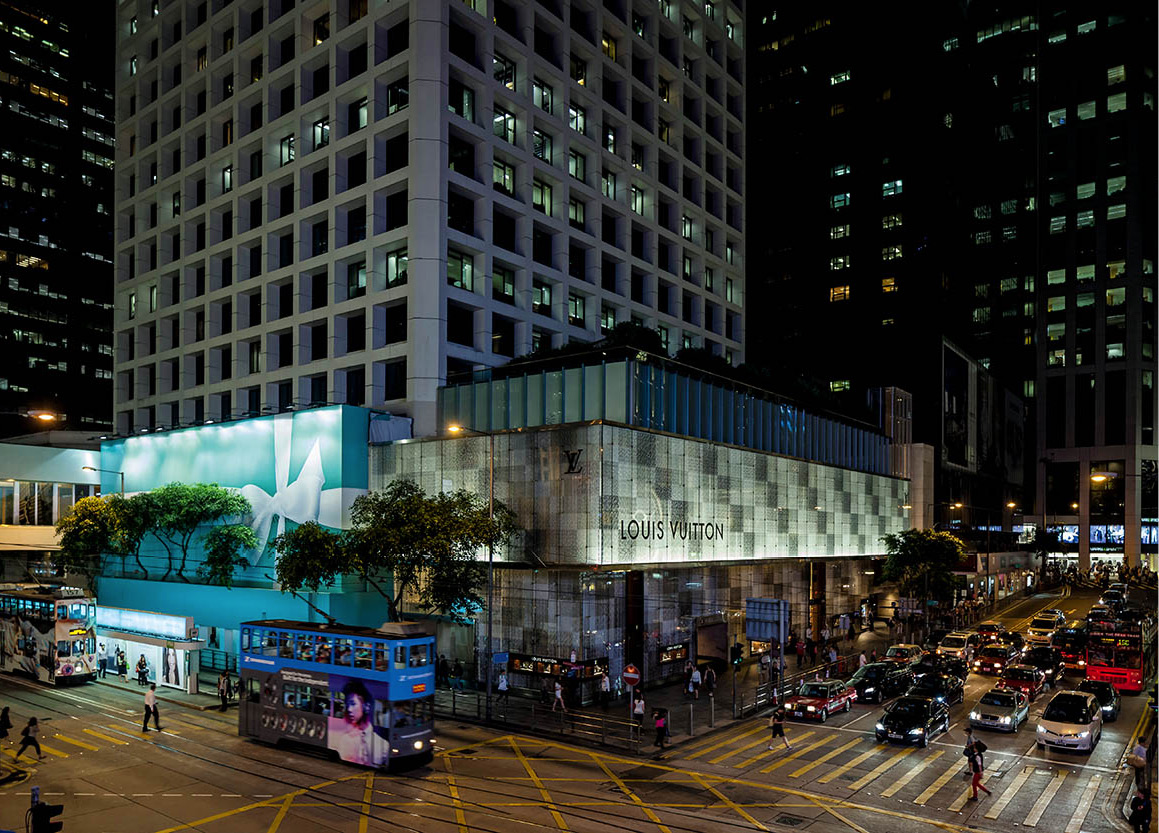
Designer stores on Des Voeux Road.
Ming Tang-Evans/APA Publications
Statue Square was once graced with a statue of Queen Victoria, long transplanted to Causeway Bay, and replaced by a statue of Sir Thomas Jackson, an Irishman who managed the Hongkong and Shanghai Banking Corporation for 30 years around the end of the 19th century. Chinese and expatriate victims of World Wars I and II are commemorated at the Cenotaph, and Hong Kong’s war veterans gather here on Remembrance Day every November.
The Mandarin Oriental 7 [map] is one of the oldest and grandest hotels in Hong Kong. It’s unusual to mention the Mandarin without the accompanying adjective “venerable”, and at four decades old it’s something of a treasure. Hong Kong’s tallest building when it opened in 1963, the hotel had a US$140 million facelift in 2006 to keep up with the new wave of rivals.
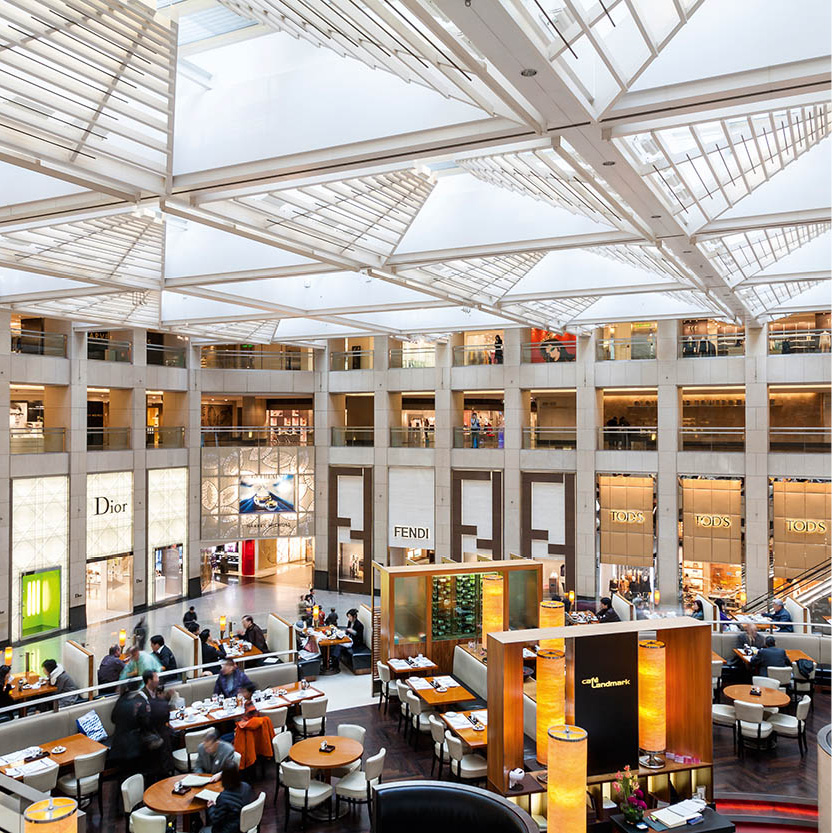
The Landmark shopping mall.
Ming Tang-Evans/APA Publications
This part of Central District is the financial hub of Hong Kong, home to the HQ of several major banks. Facing Statue Square is Norman Foster’s striking US$1 billion HSBC Building 8 [map], once the most expensive building in the world. It was completed in 1985, shortly after it was agreed that Hong Kong would be handed back to China in 1997, and built in such a way that it could have been dismantled and shipped to Singapore had things gone awry. A short way along Des Voeux Road, is the Cheung Kong Center, its dull 1999 design prompting the nickname the “box the Bank of China came in”. With feng shui concerns to the fore, the height of 283 metres (927ft) is said to have been determined by drawing a line between the Bank of China and the HSBC Building. Asia’s richest man, Li Ka-Shing is Cheung Kong’s CEO and has offices on the top floor between the financial giants.
The dramatic 368-metre (1,209-ft) Bank of China Tower 9 [map], designed by the American-Chinese architect I.M. Pei, is one of Hong Kong’s most famous buildings. Opened in 1990, its bold design and sharp angles make “cutting-edge” an unusually apt description – and these angles, pointing directly at other financial institutions, are blamed for channelling bad feng shui to them (for more information, click here). The 43rd-floor observation area is open to the public (Mon–Fri 9am–6pm, Sat 9am–1pm; free). Behind it is Citibank Plaza, another ultra-modern tower.
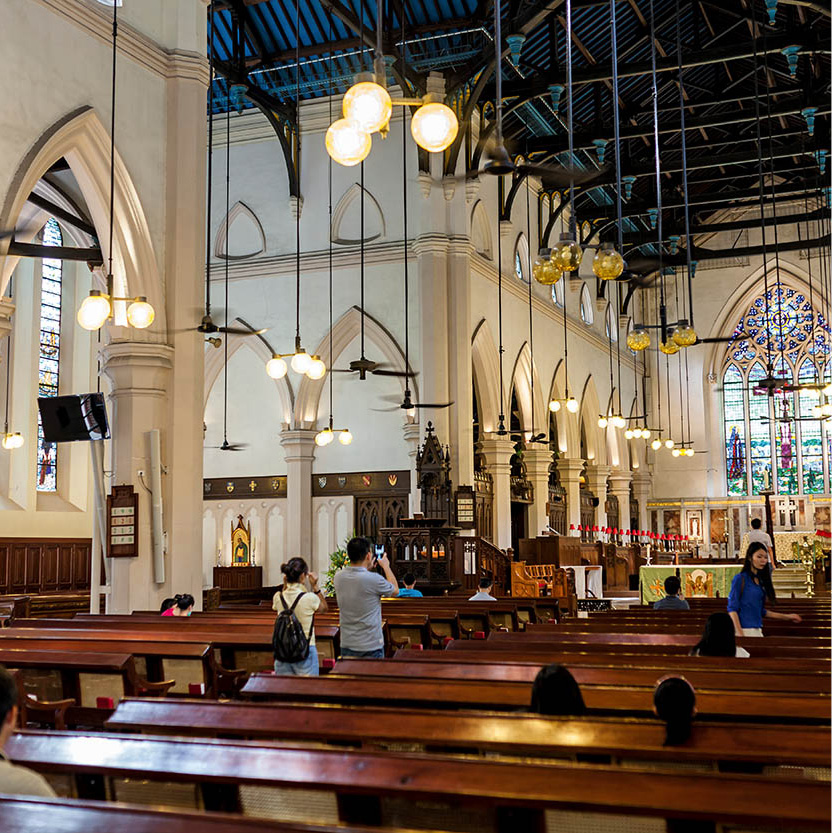
St John’s Cathedral, the city’s oldest Anglican church.
Ming Tang-Evans/APA Publications
Old Supreme Court Building
East of Statue Square is the colonial-style former Supreme Court Building and one-time home of Hong Kong’s governing body, the Legislative Council (Legco). Built in 1912, it is topped by a statue of the Greek goddess Themis, and its Edwardian dome shows up brilliantly against the Bank of China Tower. The building was used as a torture chamber by Japanese police during World War II, and wartime shrapnel damage can still be seen on the eastern wall. History will come full circle by 2015 when the building – closed since Legco moved out in 2011 – re-opens as the Court of Final Appeal. Across Jackson Road, Chater Garden is a rare open space that may host demonstrators, dancing off-duty maids or munching office workers on their lunch break. Until the 1970s, the site was occupied by the Hong Kong Cricket Club. The verandah at the northern edge of the garden is a great place to view some of Central’s iconic skyscrapers.
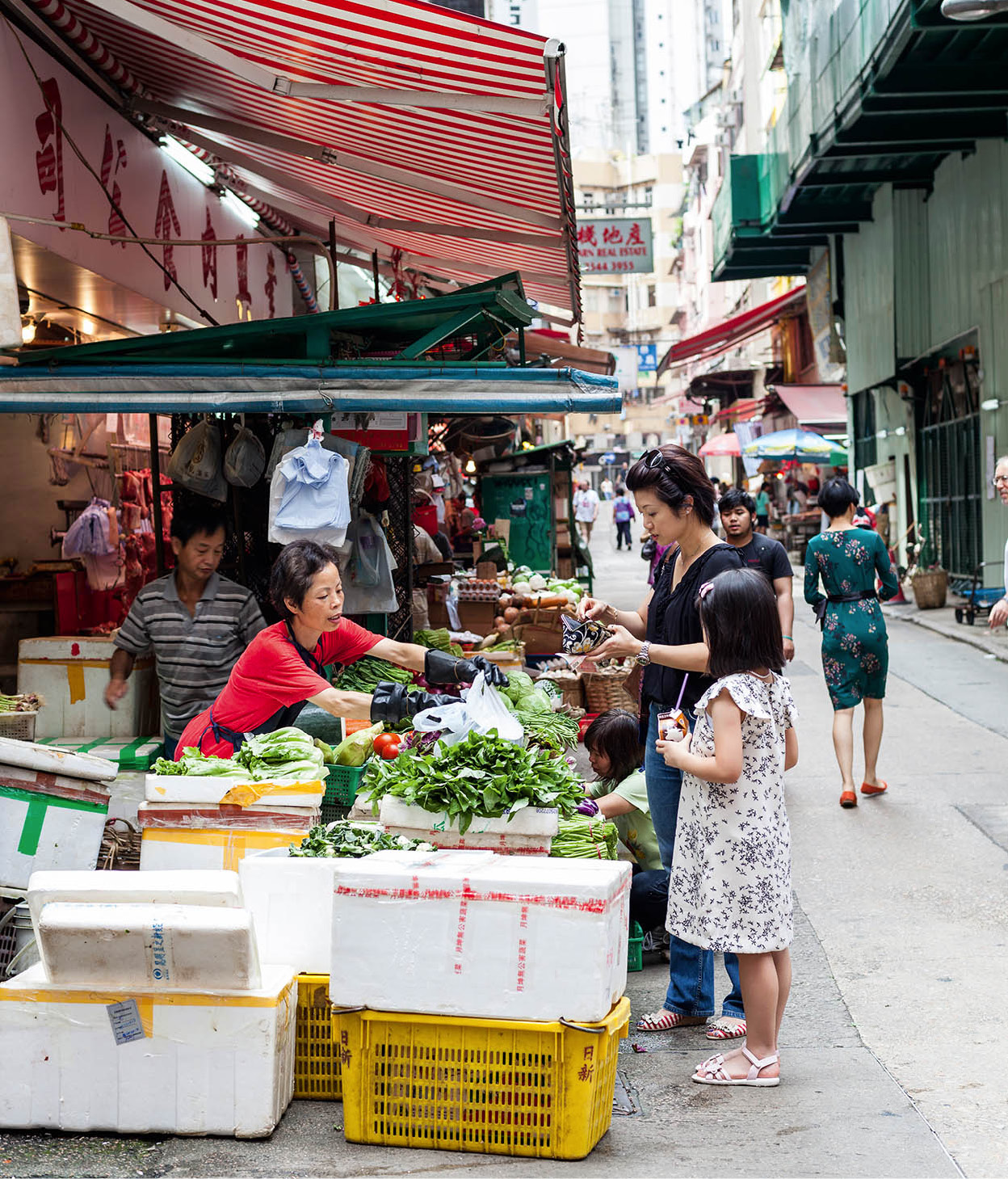
Shoppers at Graham Street market.
Ming Tang-Evans/APA Publications
Inland to Des Voeux and Queen’s roads
Heading inland from the GPO, pedestrian thoroughfares take you over Connaught Road Central to Des Voeux Road, named after Sir George William Des Voeux, governor from 1887 to 1891. The tram stop here, at the junction with Pedder Street, is a blur of traffic on weekdays. Parallel to Des Voeux, Queen’s Road Central was the area’s original “Main Street” – until a little footpath was turned into Des Voeux Road, which eventually upstaged it. These days both are very busy, although Queen’s Road has more in the way of shops.
Walking through Central
Central’s streets are clogged with pedestrians and traffic year round and are more easily navigated via the network of elevated walkways. These run from the GPO (first floor) past Exchange Square and the IFC to the Macau Ferry Terminal, and via Chater House and adjacent buildings as far as the bottom of Lan Kwai Fong. Numerous security guards en route are very obliging with directions. It the hottest months, it is quite an experience to use these walkways – moving between wilting heat and humidity and icy air-conditioning as the passage passes through a malls and office blocks. The contrast is heightened by the decibel level, which oscillates between piped music in the malls and a piledriver din on the streets.
Shopping lanes and malls
Some of the side streets connecting Queen’s and Des Voeux roads are well worth exploring. On Pedder Street, Shanghai Tang is one of Hong Kong’s most successful homegrown fashion stores. British-Chinese entrepreneur David Tang, who first brought the territory the exclusive China Club, then Cuban cigars, turned his attention to making Chinese fashion chic. Across the street The Landmark ) [map] is a prestigious shopping mall with enormous stand-alone stores dedicated to luxury brands, a four-floor Harvey Nichols department store and The Landmark Mandarin Oriental hotel. Five floors surround a vast 6,000-sq metre (20,000-sq ft) atrium. Walkways connect the floors around the atrium with neighbouring buildings: Chater House which has more than half a dozen Georgio Armani shops and an Armani bar; and Prince’s Building, with a further abundance of marble and upmarket shops.
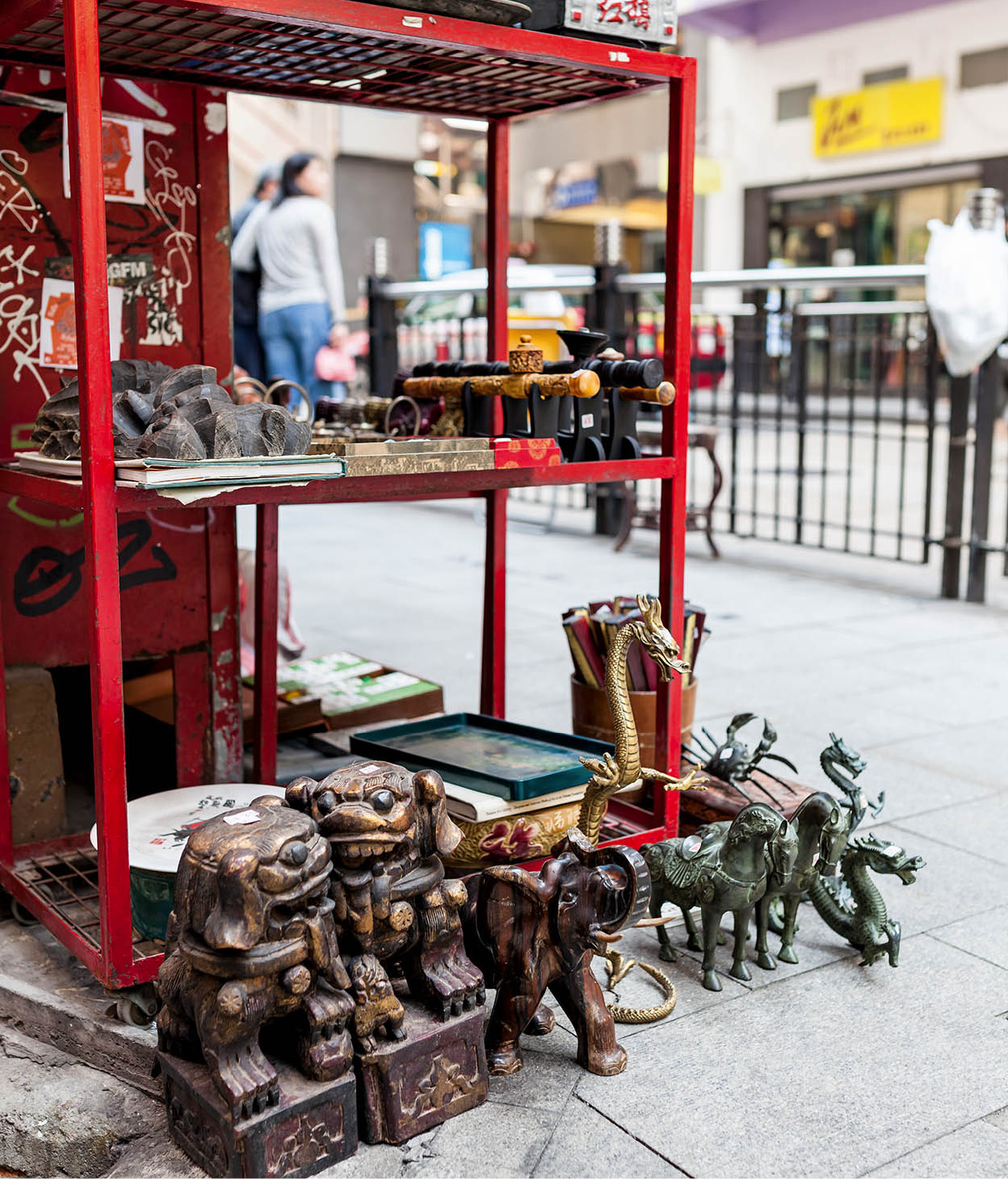
Street vendors sell their wares on Hollywood Road.
Ming Tang-Evans/APA Publications
By way of contrast, Li Yuen Street East and Li Yuen Street West, generally known collectively as The Lanes ! [map], are narrow alleyways lined with stalls and shops that sell clothing, fabrics and counterfeit designer fashion accessories. Bargaining is still expected, and the atmosphere is completely different from that of the surrounding shops and malls.
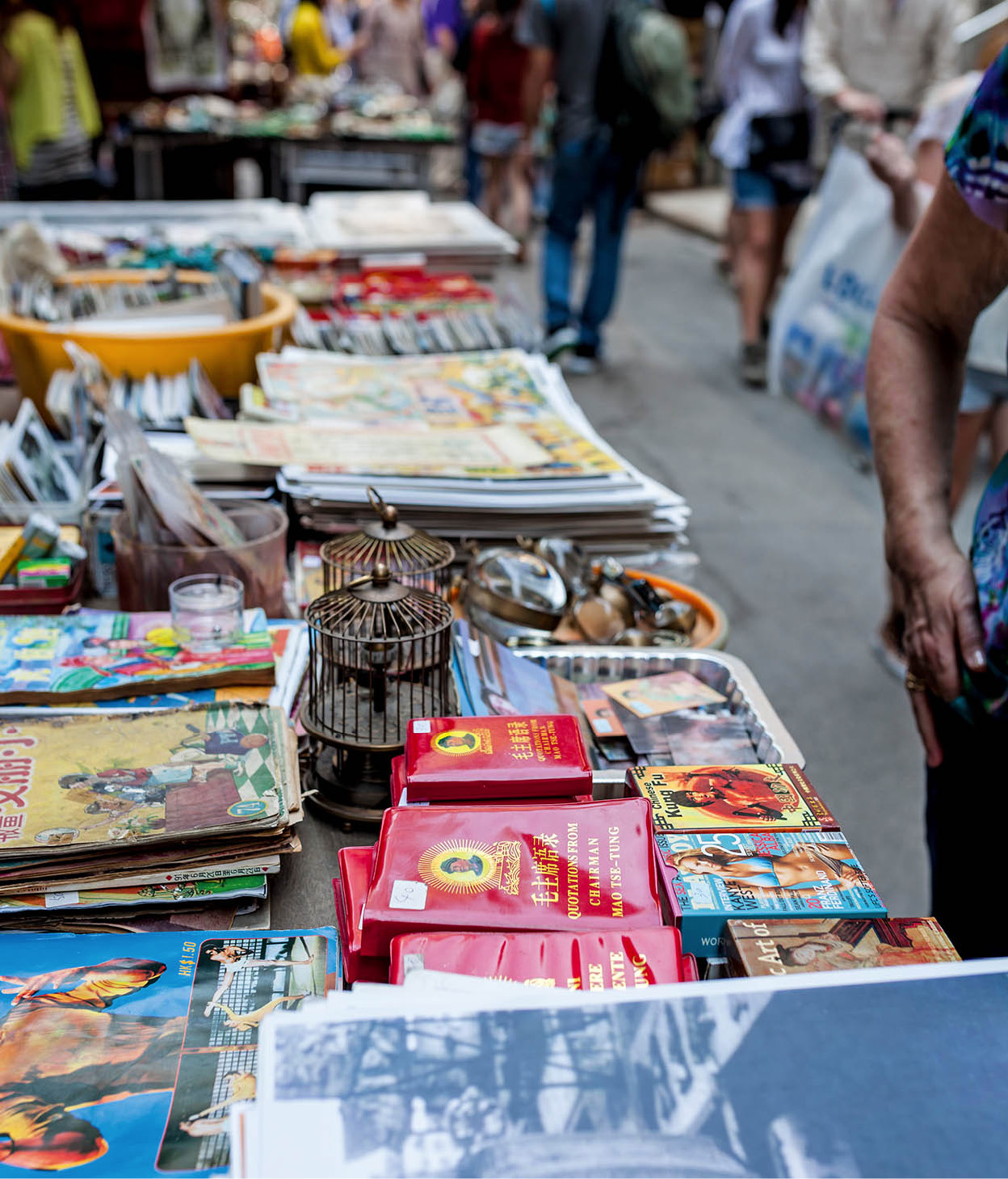
Cat Street market.
Ming Tang-Evans/APA Publications
Party central
Behind Queen’s Road Central, which was the waterfront road before land reclamation began in the 1850s, the terrain rises steeply. D’Aguilar Street leads up to the nightlife centre of Lan Kwai Fong @ [map], which together with nearby Wyndham Street and SoHo (for more information, click here) is the prime partying area for Hong Kong’s young and trendy. Modern cuisine, funky bars, clubs, English pubs and tiny snack shops generate dollars and hangovers in equal measure, and late-night revellers can get everything from pizza to sushi in the wee hours. At weekends many bars stay open until 5am (for more information, click here for listings of bars and clubs).
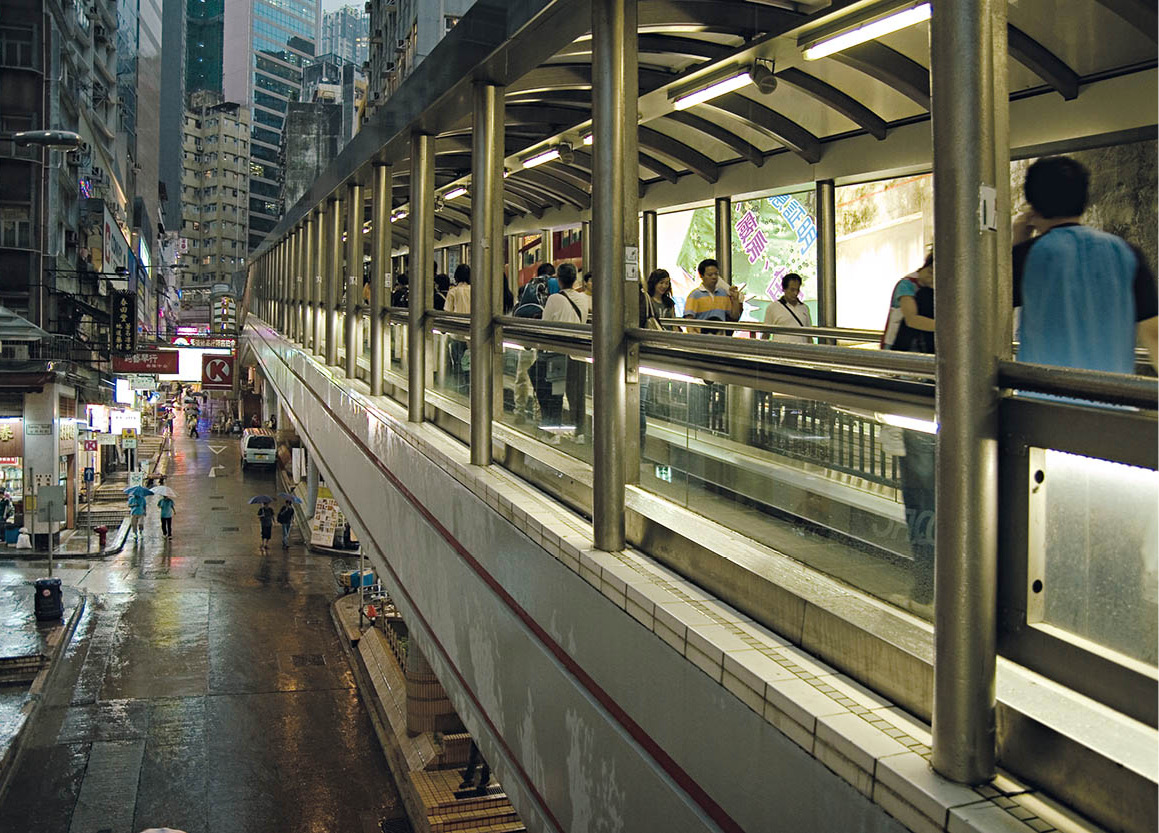
The Central–Mid-Levels escalator.
Alex Havret/Apa Publications
Colonial relics
At the top of Lan Kwai Fong, Wyndham Street marks a boundary of the commercial and residential areas. Uphill from here are the tower blocks of the Mid-Levels, with desirable and expensive apartments.
Fact
People usually assume that the dark-green forested backdrop to the famous view across Victoria Harbour is “natural”. In fact, the hillsides were stripped of their original forest cover over the centuries, and it wasn’t until the 1940s and ’50s that replanting took place. Early photographs clearly show the absence of trees, altering the scene almost as dramatically as the lack of buildings.
Glenealy (one of the few streets in Hong Kong without a suffix) snakes steeply uphill and eastward onto Upper Albert Road and Government House £ [map], the grand home of the former colonial leaders of Hong Kong. After a spell as a state guesthouse during the Tung Chee-hwa administration, it is now the official residence of the Chief Executive of the HKSAR. The mansion dates from the 1850s but was remodelled by the Japanese during World War II, who added a tower with a vague Shinto look. There is a clear view of the building through the wrought-iron gates, which are opened to the public only a couple of times a year, usually in spring and autumn (no set dates).
The surrounding area is one of the few remaining parts of Hong Kong that retains a genuinely colonial feel. If you go any further up, the pocket of exotic greenery is quickly invaded by the high-rises of the Mid-Levels; lower down, the area is engulfed by banks and office towers.
Fact
On Hong Kong Island, the higher the altitude, the more desirable the property and the higher the rents – a pattern established in the early colonial years, when the upper slopes were considered less prone to malarial mosquitoes than those closer to sea level. How high up the hill one lives has long been seen as a straightforward measure of status.
Opposite Government House are the Zoological and Botanical Gardens $ [map] (open daily 6am–7pm; free), a lush tropical retreat worthy of exploration. The small zoo houses a variety of exotic wildlife, including an impressive collection of red-cheeked gibbons. It opened in 1864 and still retains elements of its original Victorian gentility, with added Eastern spirituality courtesy of the elderly Chinese who practice t’ai chi here.
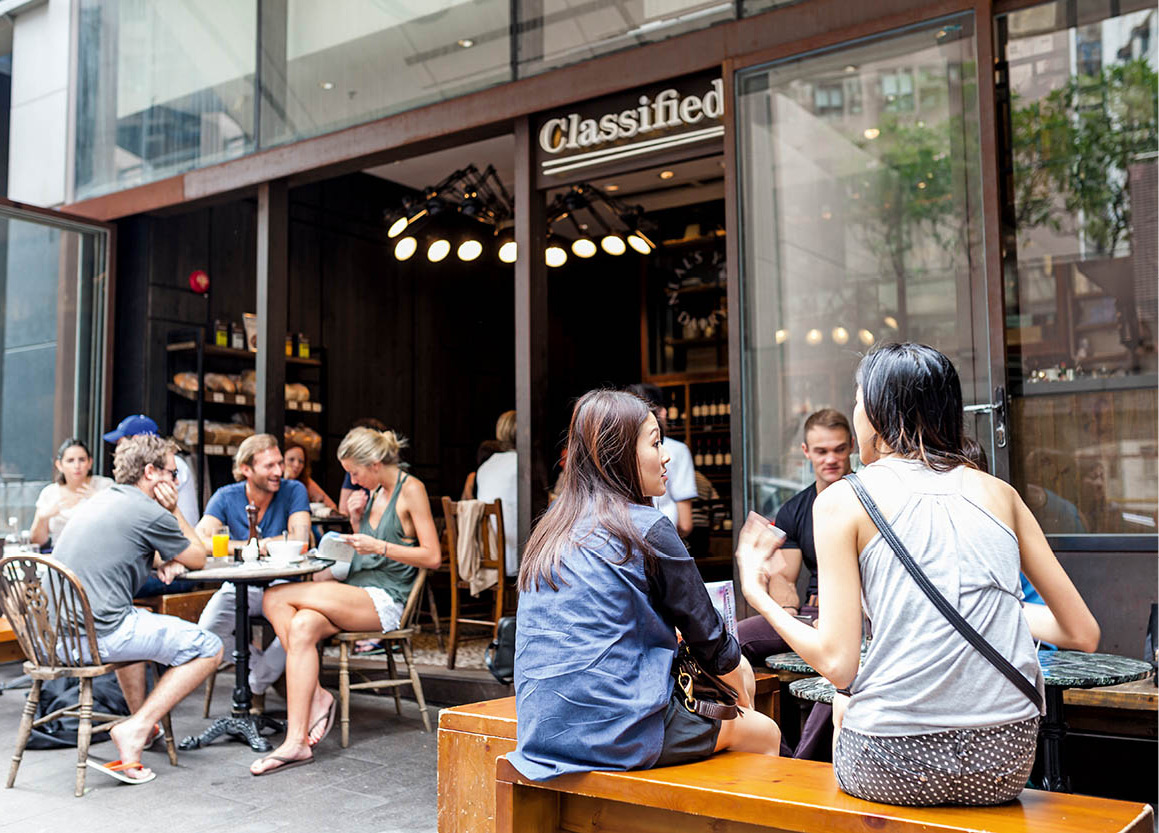
Dining al fresco on Hollywood Road.
Ming Tang-Evans/APA Publications
St John’s Cathedral
Tucked away opposite the Citibank Plaza on Battery Path Road, and just below Government House, the Victorian Gothic St John’s Cathedral % [map] was consecrated in 1849 and is the city’s oldest Anglican church. Note that Battery Path itself is a pleasant walk, beginning at the HSBC Building and leading past the cathedral to Hong Kong Park. The attractive red-brick French Mission Building, behind the Cheung Kong Center, is also more than 150 years old.
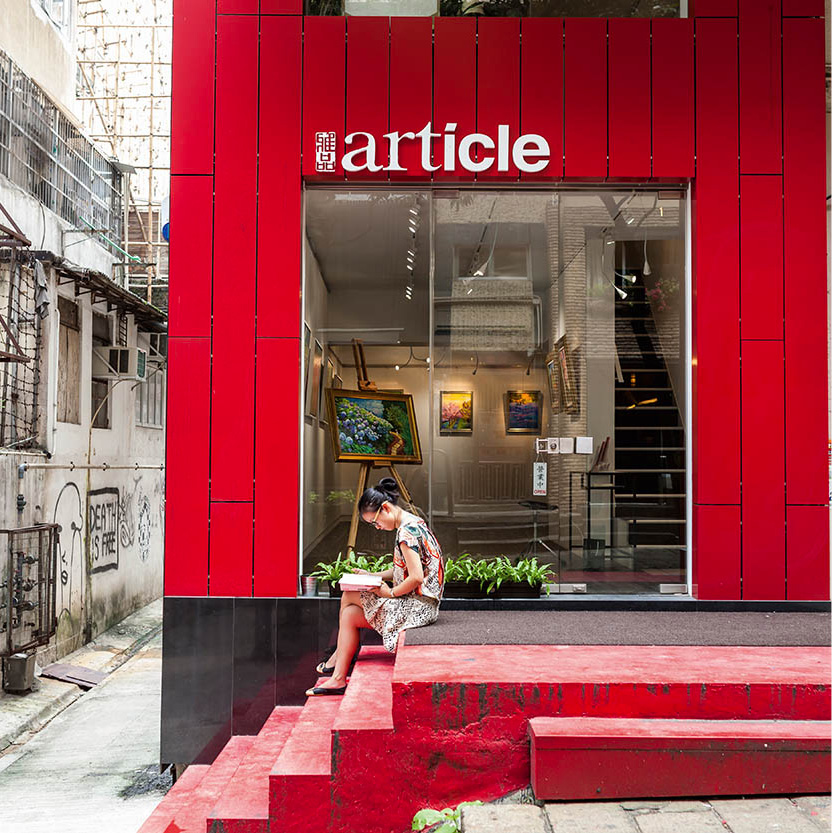
SoHo has many boutique stores including art galleries, jewellery stores and clothes shops.
Ming Tang-Evans/APA Publications
Hong Kong Park
Follow Battery Path to the east of the cathedral along the footbridge to Citibank Plaza to reach the lush, green expanse of Hong Kong Park ^ [map] (daily 6am–11pm; free). As Central’s only large open space, it is busy all day long, with t’ai chi practitioners first thing in the morning, joggers and office workers, and bridal parties posing against a backdrop of waterfalls and shrubs. The aviary (daily 9am–5pm; charge) is home to over 90 different species of birds from the rainforests of Southeast Asia, including various barbets, shamas, fairy bluebirds and bulbuls. Walk through a giant mesh up to 30 metres (100ft) high on a one-way elevated wooden walkway (enter near the Kennedy Road entrance).
The park is also home to one of Hong Kong’s best examples of bespoke architecture – Flagstaff House, home to the Museum of Tea Ware & [map] (tel: 2869 0690; Wed–Mon 10am–5pm; free). The building – of more interest than the museum – was completed in 1846 and is reputedly the SAR’s oldest surviving colonial structure. It once functioned as the residence of the commander-in-chief of the British forces, when the area was Victoria Barracks.
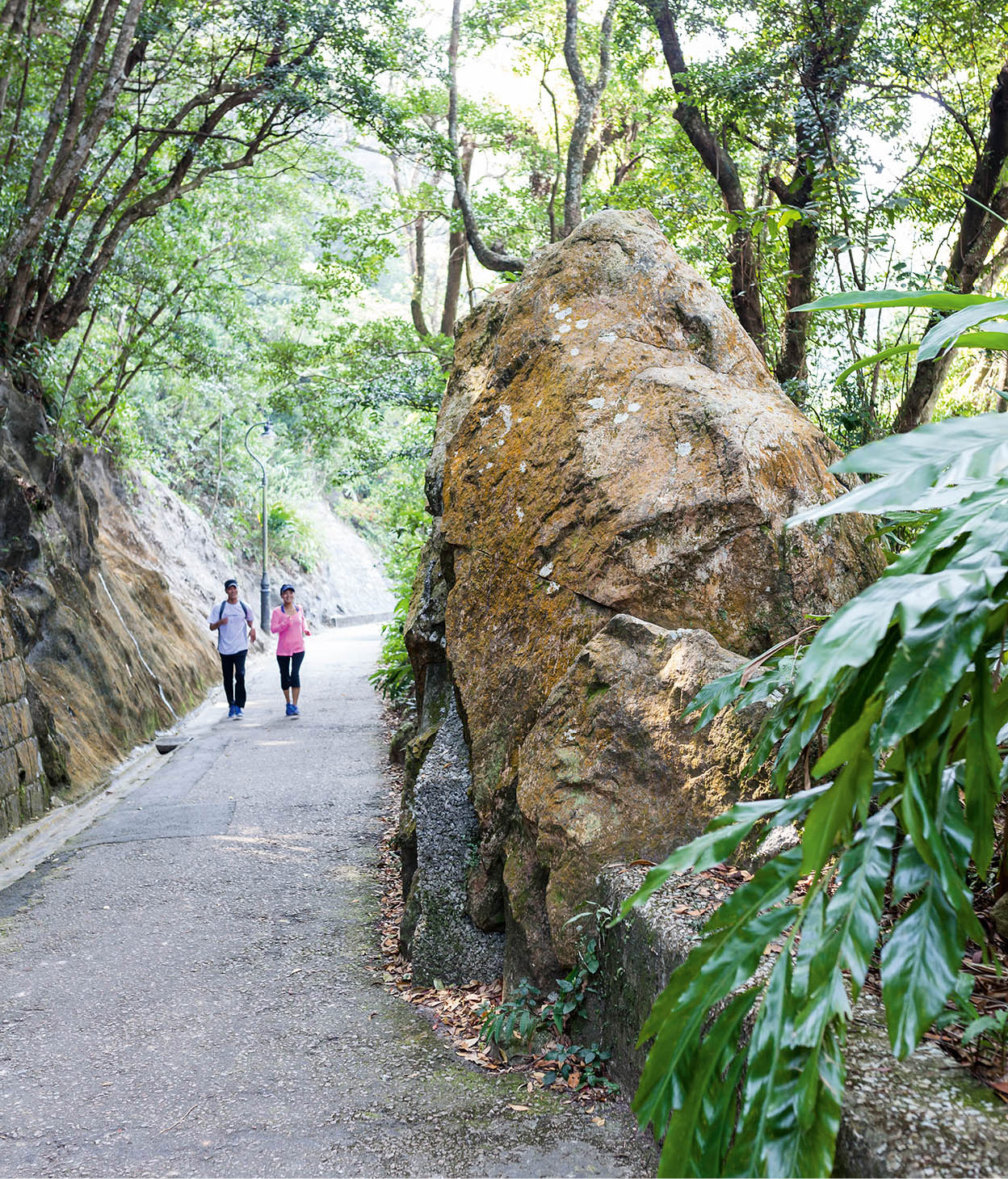
A couple on the popular Peak Trail, which offers spectacular views across the harbour.
Ming Tang-Evans/APA Publications
Around the Escalator and SoHo
The character of Central begins to change as one walks westwards along Queen’s Road Central away from the banks, shiny malls and shops and into an older, Chinese neighbourhood. The unique Mid-Levels Escalator * [map] runs through the heart of this transitional zone between Central and Western District, which in recent years has become a lively nightlife centre.
The remarkable escalator itself was completed in 1993, at a cost of HK$245 million. Comprising 20 separate sections and running to 800 metres (2,625ft), it is the world’s longest outdoor escalator system. It was built partly to ease traffic congestion in the narrow streets below, but the most significant effect has been to revive the areas alongside it. Around 54,000 pedestrians use it each day, double the original estimate.
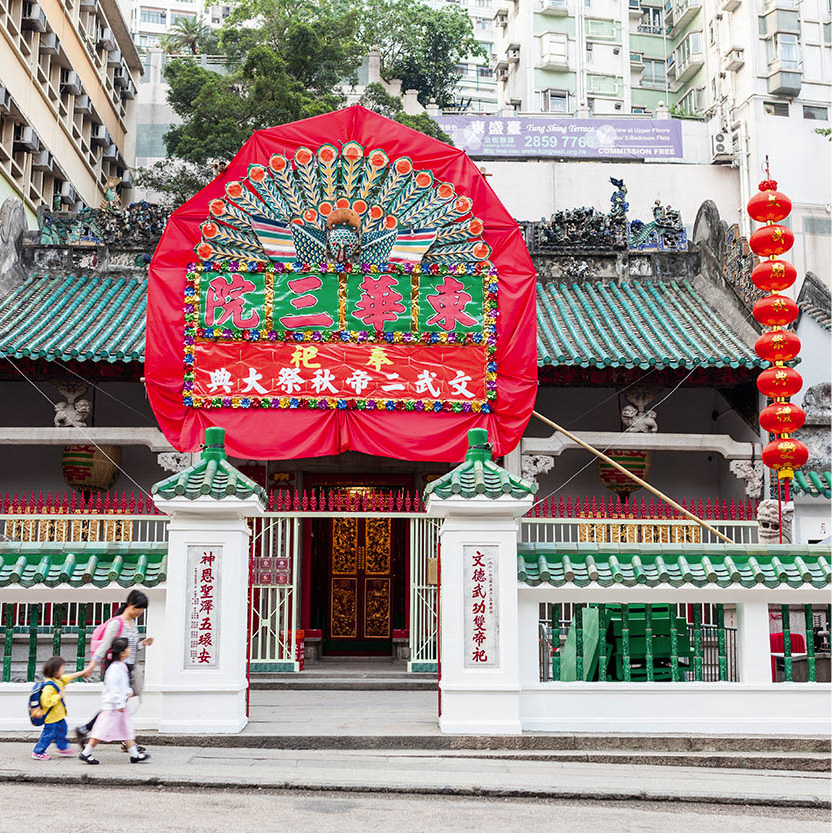
Colourful Man Mo Temple.
Ming Tang-Evans/APA Publications
The escalator starts at 100 Queen’s Road Central, emerging from the largely vacant Central Market building, to ascend the steep hillside, passing above Cochrane Street, across Hollywood Road to Shelley Street and then on to Conduit Road, up in the Mid-Levels. From early morning to sunset, canny shoppers pack Gage Street where stalls selling fresh meat, live fish and more line the street in front of noodle shops, roast meat shops and hardware emporiums. It’s worth descending to ground level on Graham Street to witness the market stalls displaying an astounding array of fresh fruit, vegetables and herbs.
Walk back up the hill to rejoin the escalator at Hollywood Road, famous for its antiques shops (for more information, click here).
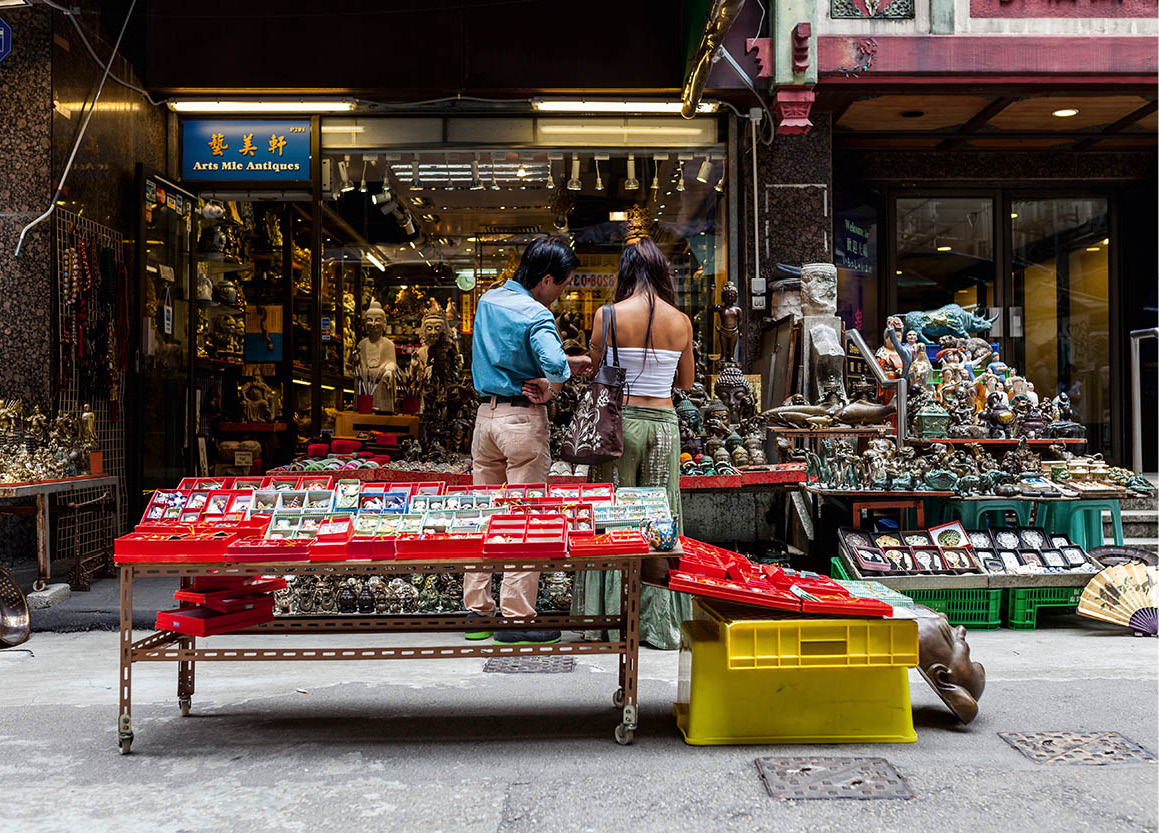
Shopping at Cat Street market.
Ming Tang-Evans/APA Publications
Tip
The streets of SoHo are known for their bars and restaurants, but there are also a lot of good shops, mostly clustered on Staunton Street. If you’re looking for non-mainstream fashion or accessories, this is one of the best places in Hong Kong.
SoHo ( [map]
Before the escalator was built, the area to the southwest of this part of Hollywood Road – Staunton, Shelley and Elgin streets – was rather run-down and seldom visited by outsiders. Now, as the hub of a nightlife area that has become known as SoHo (SOuth of HOllywood Road), these narrow streets are home to over 100 cafés, restaurants and bars, offering an ever-changing mix of venues with cuisines from all over the world, plus boutiques selling young designers’ clothes, jewellery and trendy gifts.
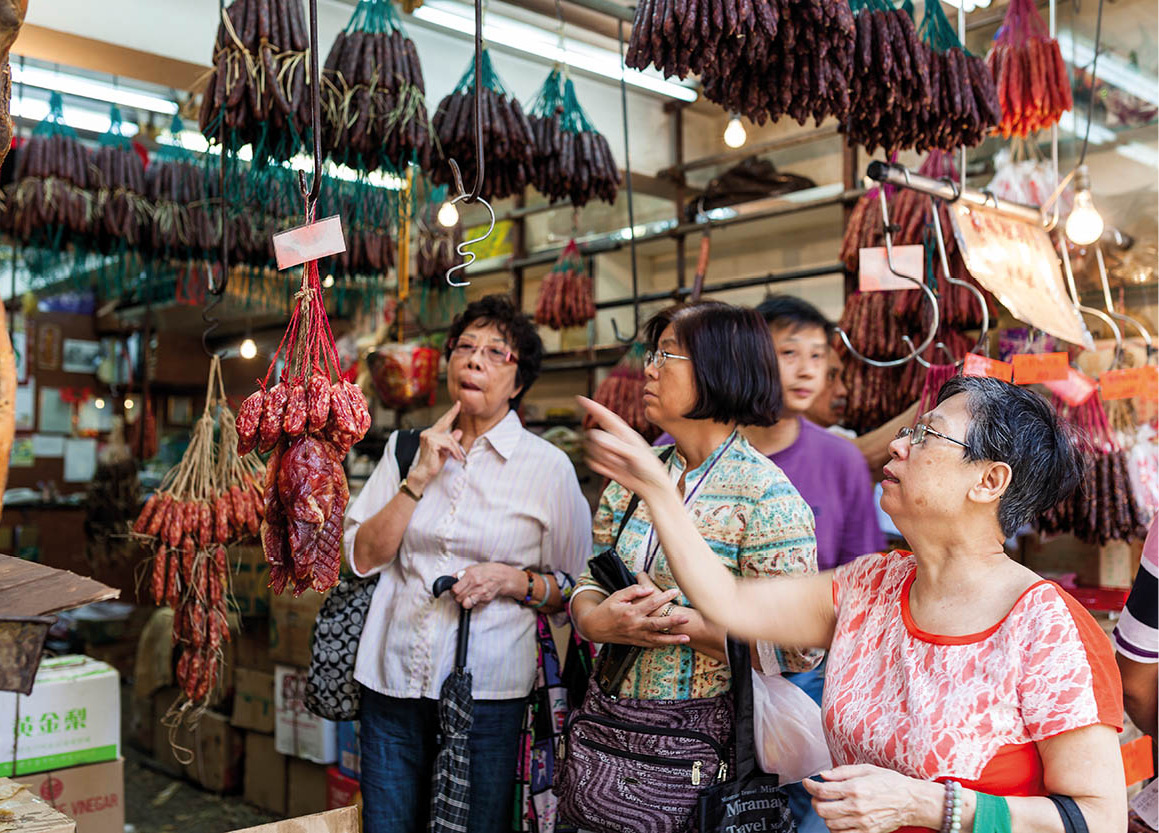
Dried food on sale at Queen’s Road West.
Ming Tang-Evans/Apa Publications
With the escalator providing easy access for people from the financial and business district, and the upmarket Mid-Levels residential area, SoHo is busy every night of the week and an easy place for the out-of-town visitor to feel comfortable and not be tagged as a tourist. Its cosmopolitan vibe and eateries have now spread in all directions in the streets near the escalator. Restaurateurs are also setting up shop in Gough Street as well as along Peel, Cochrane and Aberdeen streets. This area is sometimes called NoHo, because it lies to the north of Hollywood Road.
Old Bailey Street has a typically SoHo eclectic mix of outlets that includes Hong Kong’s New Age Shop and overlooks the now closed Victoria Prison. The prison is part of a complex that includes Central Police Station and Hong Kong Magistracy, built in stages between 1841 and 1925. There have long been plans to redevelop the attractive old complex but Hong Kong’s new-found concern with heritage preservation has scuppered several commercial designs and the future remains unclear.
Below the Former Central Police Station, Wyndham Street, which connects with Hollywood Road, is also lined with restaurants, with a few art galleries interspersed. It connects neatly with the bijou SoHo bistros with the boisterous Lan Kwai Fong nightlife area (for more information, click here for listings of bars and clubs in both areas).
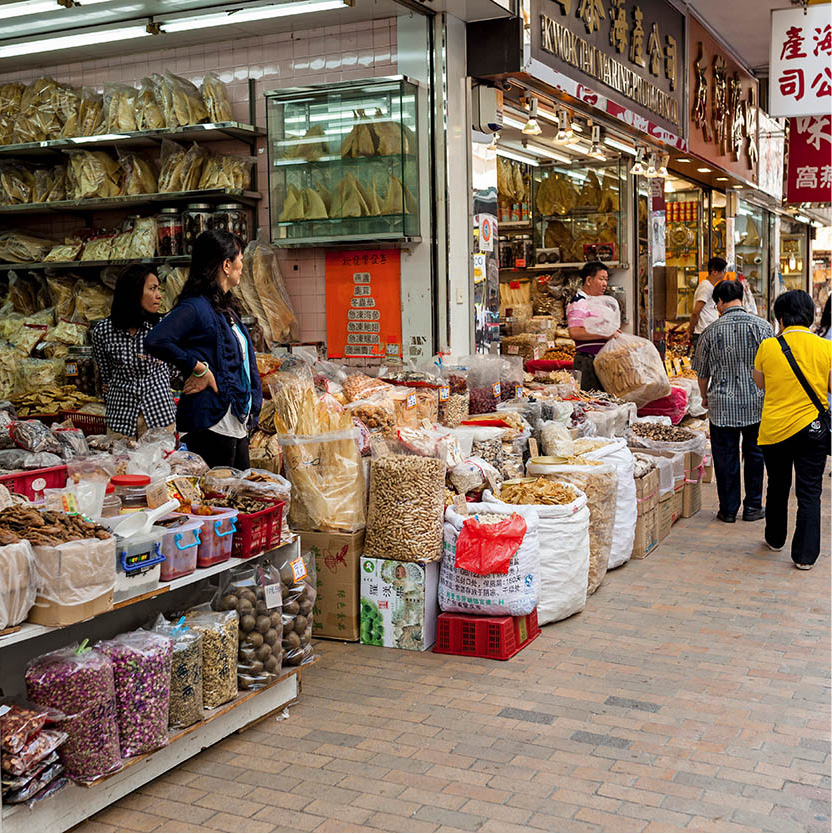
Buying traditional Chinese medicine on Queen’s Road West.
Ming Tang-Evans/APA Publications
Above SoHo
Uphill from SoHo, between Caine Road and Conduit Road, the only site of note among the apartment towers is the Jamia Masjid Mosque, which was first built in 1890 and is Hong Kong’s oldest mosque.
If you exit the escalator at Caine Road and walk for five minutes you will discover the Dr Sun Yat-sen Museum and – a few minutes’ walk further along – the Museum of Medical Sciences.
Dr Sun Yat-sen Museum
Address: 7 Castle Road, Central
Tel: 2367 6373
Opening Hrs: Mon–Wed & Fri 10am–6pm, Sat–Sun 10am–7pm
Entrance fee: charge, but free on Wed
Transport: MTR Central
Housed in a beautifully preserved mansion built in 1914, the Dr Sun Yat-sen Museum , [map] tells the story of the Father of Modern China, and his time as a medical student in Hong Kong, exploring the colony’s role in shaping his ideas about the modernisation of China – which led to revolution. While Sun never set foot in the hall, it is a useful starting point for painting a picture of the places along the Sun Yat-sen Historical Trail, which guides visitors through 12 significant sites in the Central and Western districts.
Museum of Medical Sciences
The Old Pathological Institute, built in 1906 to step up the fight against the plague and infectious diseases in Hong Kong, is today home to the Museum of Medical Sciences ⁄ [map] (www.hkmms.org.hk; Tue–Sat 10am–5pm, Sun 1–5pm; charge). The small galleries include a reconstruction of an early 20th-century pharmacy, an autopsy room, and the contrasts between Western and Chinese medicine. A chance to take a break in its small Chinese herbal medicine garden warrants a detour on the way down Caine Road or up from Hollywood Road.
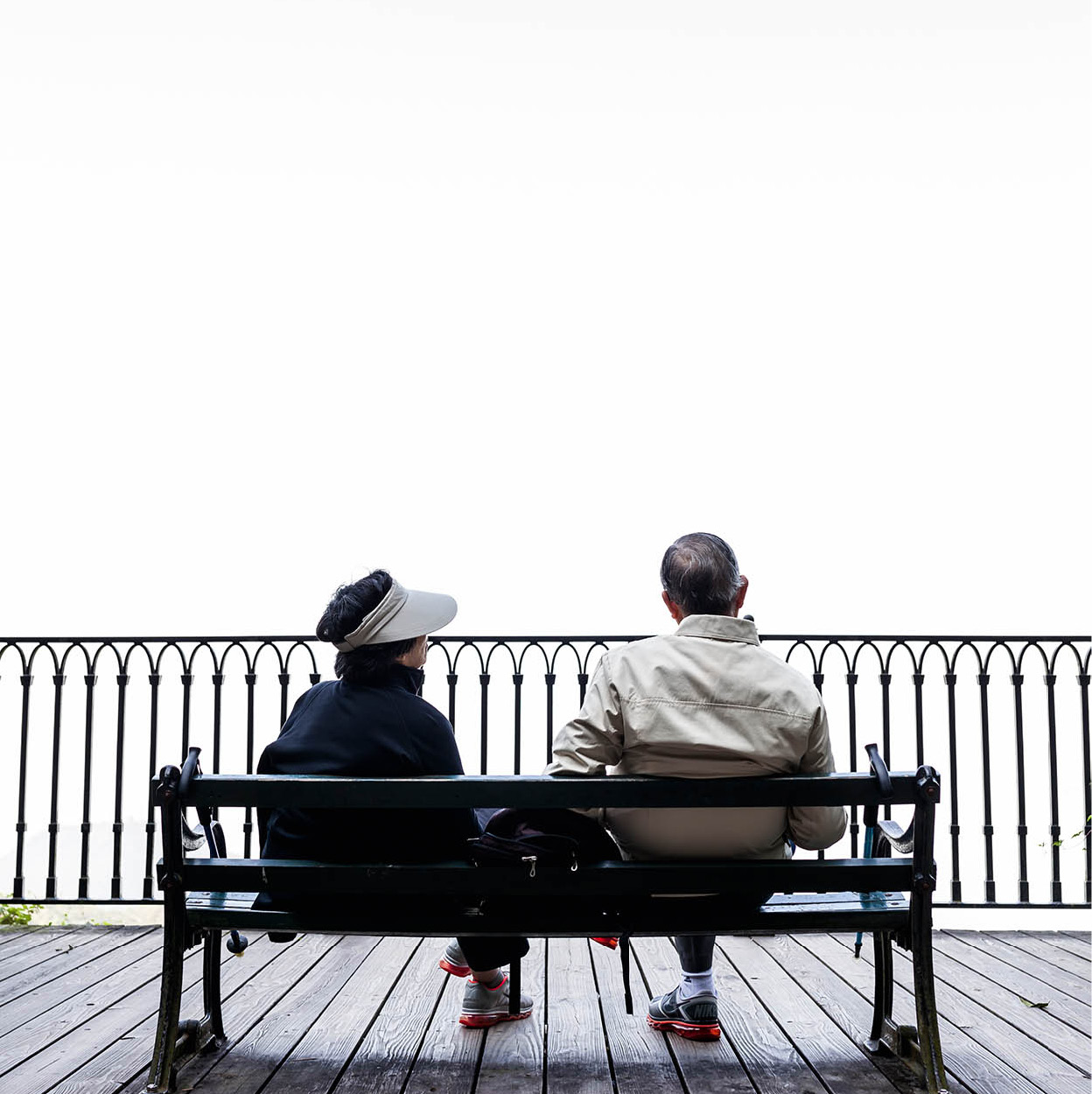
Taking a break on the Peak Trail.
Ming Tang-Evans/APA Publications
West of the escalator, Hollywood Road itself is well known for its abundance of shops selling all manner of Chinese (and other Asian) antiques, notably furniture, art and ornaments. Prices can be quite high, and – as always – it’s best to shop around and look out for the logo of the HKTB’s Quality Tourism Services Scheme (QTS; for more information, click here).
Address: 126 Hollywood Road, Central
Tel: 2540 0350
Opening Hrs: daily 8am–6pm
Entrance fee: free
Transport: MTR Sheung Wan
Follow Hollywood Road west to the corner of Ladder Street and the wonderfully dark and atmospheric Man Mo Temple ¤ [map], built around 1842 on what must have been a little dirt track at that time. Tourists regularly throng through Man Mo, but this doesn’t inhibit the temple’s regular worshippers from visiting to fill the temple with thick clouds of smoke from their joss sticks. The immense incense spirals hanging from the ceiling can burn for weeks.
Man is the god of civil servants and of literature. For most of imperial China’s history, civil servants – or Mandarins – formed the best-educated and most high-status social group. Mo is the god of martial arts and war, and is more popularly known by his worshippers as Kuan Ti or Kuan Kung. Statues of the legendary Eight Immortals stand guard outside the temple; inside, two solid-brass deer (representing longevity) adorn the main chamber. Near the altar, there are two sedan chairs encased in glass. Years ago, when the icons of Man and Mo were paraded through Western on festival days, they were transported on these chairs.
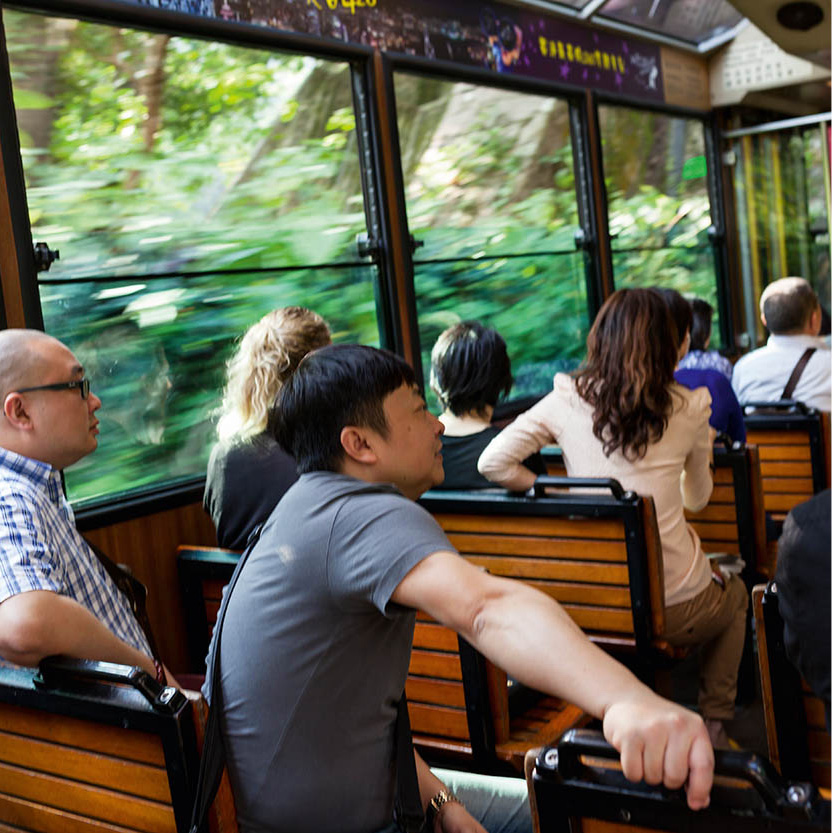
Passengers on the Peak Tram.
Ming Tang-Evans/APA Publications
Ladder Street and Cat Street
These small streets are two of the most quirky of all local thoroughfares. Named for its steepness, Ladder Street retains its 19th-century stone steps and zigzags down from Caine Road, past the Museum of Medical Sciences, to Hollywood Road and onto Queen’s Road.
Just off this last stretch of Ladder Street, below Hollywood Road, is the street officially called Upper Lascar Row but much more commonly known as Cat Street ‹ [map], so-named because this was once where sellers offloaded stolen goods, or “rat” goods in Cantonese. Customers who chased the rats were known as the ”cats”. Sellers now trade in legitimate tourist trinkets such as communist memorabilia and jade, though the “antiques” may not always be quite as old as they look. Bargaining is the rule here – whether for a safety pin, a shoelace, or, if you should be so lucky, a Tang-dynasty porcelain horse. The area was once famous for seamen’s lodging houses and brothels, and it was a hangout for criminals and low-life characters of all kinds. In nearby Lok Ku Road are the Cat Street Galleries, which are devoted to artwork and antique reproductions from all over Asia.
Continue west to Possession Street › [map], so called because it was here that Captain Sir Edward Belcher landed in January 1841 to plant the Union flag and take possession of Hong Kong for Britain. No monument marks the exact spot where the British flag was planted, though a Hong Kong Tourist Board bollard at the junction of Possession Street and Hollywood Road gives a rough approximation. Belcher Street, west of Possession Street, is named after the feted captain of the HMS Sulphur.
Western District
Western District is located just to the west of Central, but is worlds away from the ultra-modern financial district. Ironically, considering its name, this is one of the least Westernised areas of Hong Kong, and provides a rare hint of the old city. The area begins officially at Possession Street and sprawls west to Kennedy Town.
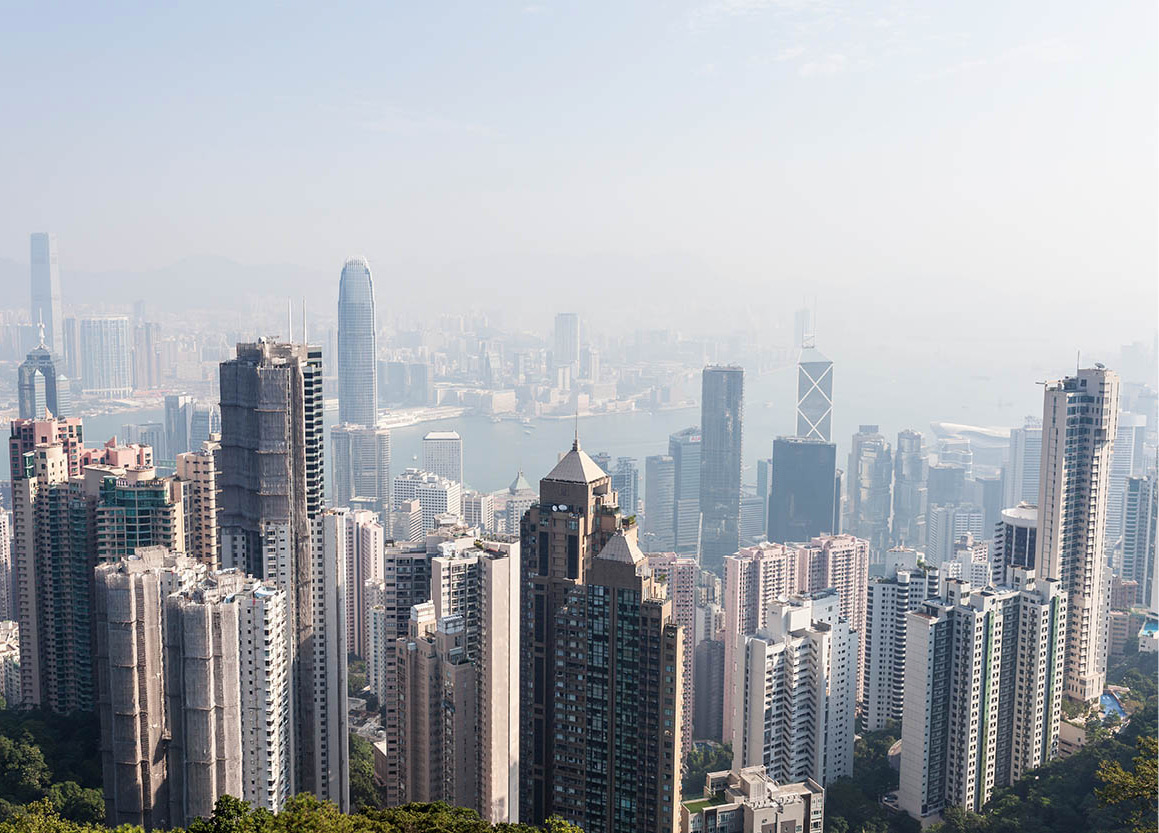
The magnificent view of Hong Kong from the Peak, across Victoria Harbour to Kowloon.
Ming Tang-Evans/APA Publications
One of Western’s charms is that it is packed with shops and merchants trading in traditional goods, tea, rice and ingredients for herbal medicine. Find a Chinese herbalist, with his aromatic concoctions of snake musk, herbs, ginseng and powdered lizards, and you discover part of a pharmacopoeial tradition dating back 4,000 years.
Sheung Wan
A buffer zone between the steel-and-glass skyscrapers of the financial district, Sheung Wan is the gateway to the more traditional, and residential, districts of Sai Ying Pun and Kennedy Town. Until recently, development here was on a building-by-building basis, so it is not unusual to find modern edifices poking up between older tenement buildings.
Heading inland from the urban expressway of Connaught Road, Man Wa Lane fi [map] is lined with the chop-makers who carve elaborate name stamps from blocks of stone. These chops are not only practical instruments (formal documents in both Hong Kong and China require a “chop”, used as a signature), but works of ancient Chinese craftsmanship. Watching a Man Wa chop-carver sculpt a customer’s name out of a small block of stone, ivory, jade or wood is an interesting experience. There are male and female chop styles: when background material is carved out, the chop is male; when the characters are carved out, it’s female. The chop is also important in other Asian countries, particularly Japan.
The heart of Western
As Queen’s Road Central becomes Queen’s Road West, the architecture becomes more traditional. Look out for the few open-fronted “shop-houses”, traditional wholesale trading houses and shops that overflow onto the pavements with a unique Hong Kong mix of everything from daily necessities to traditional Chinese medicine, money from the “Bank of Hell” and funerary items to burn at graves and handmade cake moulds and dim sum baskets.
West from Ma Wa Lane are some of the most aromatic streets in Hong Kong. Wing Lok Street fl [map], Bonham Street and Des Voeux Road West are the centre of the Chinese medicine trade in Hong Kong. Shops here specialise in selling herbs, ancient remedies, dried extracts of plants and animal parts. Specialists in delicacies such as bird’s nest abound, as do stores selling a pungent range of dried seafood, including abalone, sea cucumber and – more controversially – shark’s fin. Hong Kong is a major centre for the world’s trade in shark’s fin. Once a regional delicacy, eaten occasionally by wealthy Chinese families in a few areas of southern China, shark’s fin soup has become extremely popular throughout Greater China as a prestigious treat at banquets. With increasing wealth in the region, many species of shark are facing extinction.
One block inland on Hillier Street and Jervois Street is a mix of small teashops, cafés, print shops and merchants selling wholesale goods. It is a great neighbourhood to explore on foot, for poking into little alleys and for getting lost in the web of side streets. Look for the tea merchants, noodle specialists, Chinese sweets and preserved nuts, as well as stores selling traditional Chinese pots, pans and bamboo steamers. On the cross-streets, minuscule stalls and workshops can often occupy less than 6 sq m (20 sq ft) of space.
On Morrison Street, close to the harbour, stands Western Market ‡ [map], a red-brick Edwardian-style structure. It was opened in 1906 and served for more than 80 years as a food market. Recognised as a historical landmark, its elegant architectural features were preserved and restored, and in 1991 it was converted into a shopping complex. It offers a diversity of handicrafts, fabric and souvenir stalls, as well as a Chinese restaurant on the top floor, enlivened by afternoon “tea dances”.
From Western Market you can take a walkway across Connaught Road West to the Shun Tak Centre, which houses the Macau Ferry Terminal. Now you are in Western proper: the name of this neighbourhood, Sai Ying Pun, means “Western military camp” and is so-named for the British camps which were established here in the 1840s. The steep steps of Centre Street connect Bonham Road with Queen’s Road West, and the architecture betrays the historical boundaries. The Chinese were not allowed to live above High Street in the 19th century and the area retains a flavour of an older Hong Kong, with small earth-god shrines outside each shop. Above High Street, European architecture reappears, especially around Hong Kong University, which was founded in 1911.
Further west
From Western it is possible to walk up towards the residential district of Pok Fu Lam. The hilly upper part of Western (which is actually part of the Mid-Levels) is quite different. Here the architecture is more Portuguese colonial than traditional Chinese – with tiled pitch roofs, stucco walls and projecting balconies. The University of Hong Kong has its campus here. The University Museum and Art Gallery (Mon–Sat 9.30am–6pm, Sun 1–6pm; free; bus 3B, 23, 40, 40M or 103) at 94 Bonham Road is worth a look. Housed in the 1930s Fung Ping Shan Building, it contains an interesting collection of pottery and porcelain dating back to the 7th century, although the most prized possession is the world’s largest collection of bronzeware from the Yuan; contemporary art is exhibited in the adjoining T.T. Tsui Building. It also has a welcoming Tea Gallery where you can pause over a cup of Chinese tea.
Beyond the university is the residential district of Pok Fu Lam, while down by the harbour, Kennedy Town ° [map] is one of Hong Kong’s oldest Chinese settlements, and one of the cheapest places to live on Hong Kong Island. Also here is the result of another huge land-reclamation project – the new Western Harbour Crossing, Hong Kong’s third cross-harbour tunnel to Kowloon.
The Peak, properly though rarely called Victoria Peak · [map] (Shan Teng in Cantonese), is Hong Kong’s most notable natural landmark, the residential aspiration of the upwardly mobile population and destination to more than 7 million visitors a year.
Yet it wasn’t always regarded with such awe. A travel writer once described it as “beautiful in the distance, but sterile and unpromising upon more close examination” (although that this was before reforestation took place –for more information, click here), and during the first six years of Hong Kong’s history, hardly anybody travelled to its inhospitable heights. But as Hong Kong developed as a colony, the British sought out a hill resort away from the hot, malaria-infested lower elevations. Once the Peak Tramway was opened in 1888, the area quickly developed into one of the most sought-after places to live in Hong Kong – and has remained so ever since.
The Peak Tram
Of Hong Kong’s many and impressive engineering marvels, the Peak Tram remains one of the most impressive. Rising 396 metres (1,299ft) in just seven minutes, up gradients as steep as 27 degrees (1 in 2), the tram has been hauling human cargo up and down Victoria Peak since 1888, and hasn’t had a single accident to date. There are only two cars, a clue that this is not a tram in the conventional sense, but rather a funicular, with the two carriages counter-weighting each other. Each holds 72 passengers and one driver and is pulled on 1,500-metre (5,000-ft) steel cables wound on drums. The lower Garden Road terminus can be accessed by free open-top double-decker bus from Central Pier, while the upper terminus empties out into the Peak Tower mall. Trains run from 7am to midnight daily.
The Peak Tram is also occasionally used by those who live in one of Hong Kong Island’s most gentrified neighbourhoods. In pre-tram days, long-suffering “coolies” used sedan chairs to transport the gentry up the mountainside. Such transportation disappeared long ago, but palanquins – large, covered sedan chairs – are still sometimes used during charity races.
The upper terminus of the Peak Tram is the Peak Tower º [map]. Shaped like a wok, this is for many people one of the ugliest buildings in Hong Kong. Of course, the main reason for coming up to The Peak is to marvel at one of the world’s finest vistas, which on Hong Kong’s increasingly rare clear days should include a view all the way to mainland China. Many find the night-time views even more incredible, a vast glittering swathe of electric light, most spectacular immediately below in Central and Wan Chai as the buildings attempt to outdo each other in their eye-catching displays. The Peak Tower was renovated in 2006, adding new shops, restaurants, and significantly more windows to make the most of the views. Best of all, the viewing platform was raised 30 metres (100ft) to the top of the “wok”. Now renamed the Sky Terrace (daily Mon–Fri 10am–11pm Sat, Sun 8am–11pm, charge), you can enjoy a superb 360-degree panorama. There is also a Sky Gallery with regular outdoor exhibitions.
For indoor entertainment, the Peak Tower has its very own Madame Tussaud’s (www.madame-tussauds.com.hk; daily 10am–10pm; charge), with over 100 waxworks of Asian and international celebrities that delight photo-op-crazed visitors.
Peak walks
There are a variety of superb walks from the Peak Tower. The Peak Trail follows Lugard and Harlech roads to complete a circuit of Victoria Peak, affording magnificent views across the harbour and Kowloon to the north, Cheung Chau and Lantau to the west, and the great masses of junks and sampans at Aberdeen to the south, with Lamma Island beyond. This gentle 3-km (2-mile) walk, well signposted and shaded from the sun, takes about 50–60 minutes round-trip from the Peak Tower.
The area around the Peak Tower is in fact Victoria Gap, whereas the summit of Victoria Peak itself (552 metres/1,811ft) lies to the west. Follow the Peak Trail until you reach Mount Austin Road, which winds up to the attractive Victoria Peak Gardens. The summit itself, with its pair of radio towers, is out of bounds.
It is possible to walk back down to Central and indulge in some of the finer views and footpaths through The Peak’s wooded slopes. The Central Green Trail – marked by 14 bilingual signboards highlighting points of interest – winds its way down from Barker Road, across May Road and then via paths named Clovelly, Brewin and Tramway back to the Garden Road terminus. Another short, steep route through the forest, signposted to the Mid-Levels, descends northwards from Findlay Road (just below the Peak Tower) to the beginning of the Old Peak Road. A popular longer walk descends westwards through Pokfulam Country Park, and constitutes Stage 1 of the Hong Kong Trail. For more ambitious hikers, the rest of the trail heads east for some 50km (30 miles) all the way to Tai Tam and on to Shek O (for more information, click here). Nature-lovers can wander through forests of bamboo and fern, stunted Chinese pines, hibiscus and vines of wonderful, writhing beauty. Ornithologists log sightings of birds such as blue magpies and crested goshawks.
Shopping
Central is home to some of Hong Kong’s most upmarket malls, though creeping gentrification is not the whole story. There are a handful of bustling outdoor street markets while up the hill slightly, in SoHo, are clusters of indie stores. Across in Western the shopping scene is characterised by Chinese stores selling foodstuffs and medicinal products. Even the peak offers no respite from commercial fever: there are no less than two malls close to the Peak Tram Terminus, the Peak Galleria and the Peak Tower.
Department Stores
Wing On Centre
211 Des Voeux Road Central, Sheung Wan. Tel: 2852 1888. www.wingonet.com
Wing On has been selling dependable, no-frills clothing, jewellery and accessories in Hong Kong since 1907. Tourists can claim between 5–10 percent discounts on presentation of their passports.
Malls
IFC Mall
5–7 Edinburgh Place. Tel: 2521 1303.
Over 200 international brands, smart restaurants and a cinema. Has one of four outposts of Hong Kong’s premier homegrown department store, Lane Crawford.
The Landmark
15 Queen’s Road Central, Central, Hong Kong. Tel: 2500 0555. www.landmark.hk.
Over 250 shops focusing on famous names from fashion, leather goods and jewellery. Contains Louis Vitton’s Asia flagship store as well as the posh Harvey Nichols department store.
Prince’s Building
10 Chater Road, Central
Exclusive mall for antiques, homeware, jewellery, expensive gifts and a deluxe delicatessen. Has a preponderance of upmarket, boutique-style shops.
Western Market
323 Des Voeux Road Central, Sheun Wan. Tel: 6029 2675. www.westernmarket.com.hk
More appealing for the Edwardian architecture than the shops, which tend toward traditional souvenirs like tea, Chinese seals and jade jewellery.
Markets
Cat Street
Upper Lascar Row, nr Hollywood Road, Central.
Flea market offering inexpensive trinkets and bric-a-brac. The surrounding area is famous for its antiques.
The Lanes
Li Yuen Street East and West, Central.
Parallel lanes selling seconds and factory over-runs, plus a range of miscellanea and curios. Plenty of bargains to be had.
Pottinger Street
Central.
Lined with small stalls selling fancy-dress costumes, wigs, inexpensive accessories, shoes and party decorations.
